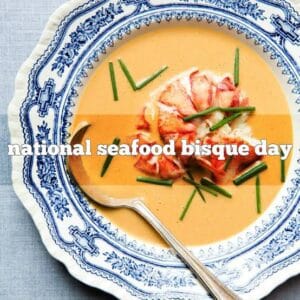National Seafood Bisque Day – October 19, 2022, history, significance
National Seafood Bisque Day comes up every year on October 19 and we’re excited to help you celebrate. Originating in France, bisque is a thick and creamy soup, seasoned with any choice of seafood, including crab, shrimp, and crayfish.
HISTORY OF NATIONAL SEAFOOD BISQUE DAY

Little is known about the history of National Seafood Bisque Day, but the history of the bisque dish itself is a little fishy. According to historians, the word “bisque” is derived from the French phrase, ‘bis cuites,’ which means ‘twice-cooked.’ The method for cooking a bisque is a reflection of this, as it must be cooked twice, the first time with stock and again, with cream.
However, there is a dispute surrounding the name as another set of people believe the word originates from the Bay of Biscay, a gulf along the coast of France and Spain. Indeed, the meals from that region have very similar ingredients to those of bisque.
The first use of the word “bisque” is traceable to the 17th century. Although today the bisque has been accorded the status of a fancy soup, this wasn’t always the case. In fact, it was the opposite.
The soup was mostly eaten by fishermen, who used finely crushed shells, derived from whatever fish was available at the time. It was when shellfish became a scarcity that prices of seafood went up, driving bisque to the top of the food chain and earning it a cushy reputation. Bisque is now one of the few dishes at the top of the culinary pecking order.
The basic ingredients used in a bisque are shellfish broth, cream, spices, and, occasionally, a dash of cognac, sherry, or brandy. The main choices of seafood used are shrimp, crab, and lobster, though recently, people have begun using clam and crayfish as well. An even more daring twist involves the use of mushrooms, tomatoes, or even pumpkins as a replacement for shellfish. Whatever you prefer to use, National Seafood Bisque Day is surely the most fitting day to enjoy this aromatic meal.
NATIONAL SEAFOOD BISQUE DAY TIMELINE
1600s
The Origins of Bisque
The word “bisque” comes into use.
1840s
Lobster Fisheries are Established in the U.S.
Commercial fisheries for lobster are established in Maine.
1965
An International Fishery Committee is Founded
The U.N. Food and Agriculture Organization (FAO) Committee on Fisheries (COFI) is formed.
2007
The Earliest Known Seafood Dish is Discovered
Researchers discover a bowl of shellfish in South Africa, dating back 165,000 years.
HOW TO CELEBRATE NATIONAL SEAFOOD BISQUE DAY
Make seafood bisque
Celebrate by making your own seafood bisque. Add your own unique twist with ingredients of your choice.
Visit a restaurant
If you can’t find the time to make your own, indulge in some fine dining at a restaurant near you. Order a plate of seafood bisque and enjoy!
Use the hashtag
Spread the fun by taking a picture of your bisque and using the hashtag #NationalSeafoodBisqueDay in a social media post.
5 INTERESTING FACTS ABOUT SEAFOOD
The freshness test
If you want to figure out whether fish is fresh or not, place it in a bowl of water. If it floats, it’s fresh, and if it sinks, it’s not a recent catch.
Sodium balancer
Consuming fish can reduce the level of sodium in the body.
Water purifier
Shellfish can purify water, able to filter about 15 to 20 gallons of water a day.
Stubborn oysters
To get an oyster out of its shell easily, soak it in club soda for a few minutes and it will slide right out.
Good for your heart
Certain fish, such as salmon, tuna, trout, and herring, contains omega-3 fatty acids, which help prevent heart disease.
WHY WE LOVE NATIONAL SEAFOOD BISQUE DAY
Seafood bisque is super delicious
With the right recipe, seafood bisque is incredibly tasty, while still being simple and easy to prepare.
There’s a variety of seafood bisque recipes
Seafood bisque is a flexible dish, as it can be made with any kind of seafood. Whether you prefer crab, crayfish, or lobster, the choice is yours!
Seafood bisque can be simple or elaborate
Seafood bisque is awesome because it’s one of the few dishes that can pass for a casual meal and still be elegant enough when it’s time to get fancy.



